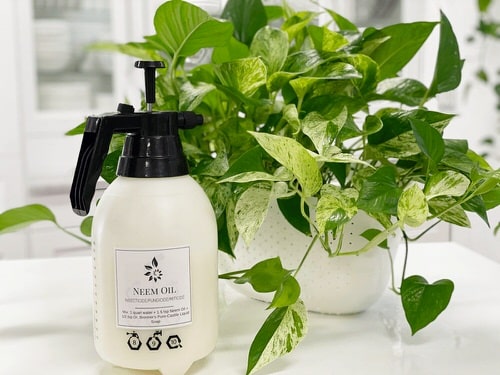Use Neem Oil for Indoor Plants to save them from pests and diseases naturally. It gives you an organic and safe solution!

If you want to get rid of pest problems for your indoor plants without using chemicals then follow these Tips to Use Neem Oil for Houseplants!
Read about coconut oil uses in the garden here
Why Use Neem Oil For Houseplants?
Using pesticides for houseplants can be really harmful as research indicates that exposure to them can lead to lymphoma, leukemia, brain, breast, kidney, lung, ovarian, pancreatic, prostate, and stomach cancer.
So, what is the best alternative? This is where the neem oil comes to your rescue! Being completely natural and amazingly potent in killing most of the house pests, it does its job organically, posing no harm in any way. It is also safe for your kids and pets.
According to this study, the bodies of insects absorb the neem compounds as if they were the real hormones, and this blocks their endocrine systems. The resulting deep-seated behavioral and physiological aberrations leave the insects confused and make their brain and bodies unable to reproduce, and their populations plummet.
Blocking the larvae from molting is the neem’s most important quality, which prevents the pests from multiplying further. While it doesn’t kill them instantly, they stop feeding on plants and die a slow death.
The best part is neem oil does not harm the plant in any way when used in the specified amount.
Check out some amazing neem oil uses in the garden here
Tips to Use Neem Oil for Houseplants
1. Neem Oil Spray for Indoor Plant Pests

Make a solution of 10 ml neem oil in 500 ml of water and spray it on the foliage to get rid of powdery mildew. You can use it for any houseplant suffering from the disease. Make sure to shake the bottle well before use.
You can use it on many indoor plants like Begonias, Poinsettia, Jade, Rosemary, Pothos, Kalanchoe, and African violets.
2. Get Rid of Aphids
You can safely get rid of aphids by using neem oil. Mix 1 teaspoon of organic neem oil with 2 to 4 teaspoons of mild liquid soap in a liter of water. Fill the solution in a spray bottle, shake well, and mist it on the affected areas of the plant.
You can use it for your outdoor plants as well if you’re looking for chemical-free pesticides.
3. Kill Whiteflies with Neem Oil

Neem oil can control the invasion of whiteflies—it has residual effects as well that repel and keep them away from coming again. Take half a teaspoon of neem oil, mix it with a teaspoon of liquid soap, and mix them in a liter of water.
Combine all ingredients together and fill the solution in a spray bottle—use it directly on the foliage of your plants and on the whiteflies.
Note: Always do a small test by applying the solution on one or two leaves before using it on the entire plant.
4. Use Neem Oil on Thrips
You can get rid of thrips by spraying the solution of half a teaspoon of neem oil, and a teaspoon of liquid soap and mixing in a liter of water. This blend will kill bugs.
5. Control Houseplant Scale

Neem oil is an excellent insecticide for houseplants and quite helpful in treating scales on indoor plants. Take half a teaspoon of neem oil and dissolve it in a teaspoon of liquid soap and a liter of water. Fill it in a spray bottle and spray it on the affected area.
6. Prevent Mealybugs
Neem oil will take some days to treat mealybugs before killing them, though it has a residual effect that works to prevent future infestation as well.
Take half a teaspoon of neem oil, mix it with a teaspoon of liquid soap, and mix them in a liter of water. Spray the solution on the plant.
7. Repel Fungus Gnats

Mix half a teaspoon of neem oil with a teaspoon of liquid soap and mix them in a liter of water. Now, pour this solution into the pot to get rid of fungus gnats. Before repeating the process, water the plant well.
8. Remove Spider mites
Neem oil is quite helpful in preventing spider mite infestation, though it takes some time and need repetitive application. For best results, wipe the leaves with a damp cloth before using the neem oil remedy.
Recipe:
- 1 tsp mild liquid soap
- 1/2 tsp neem oil
- 1-liter lukewarm water
Mix the contents together, fill the solution in a spray bottle, and use it on affected areas of the plant.
9. Bring Shine to the Leaves

Mix one-quarter of a teaspoon of neem oil in half a teaspoon of liquid dish soap, and add all in a liter of water, and rub this solution on the leaves using a soft cloth to bring back the shine!
Note: Always do a small patch test on a leaf.
10. Mosquito Repellant
Indoor plants act as a perfect place to shelter mosquitoes. Spray neem oil around the plants and areas where you spot them to repel mosquitoes.
Recipe: Mix 2 ml neem essential oil in 100 ml coconut or other carrier oil and apply it to the exposed skin. Read the details here.
Check out 17 DIY homemade mosquito repellant ideas here
Neem Oil Insecticide Recipe
Make an organic neem oil pesticide for indoor plants. You can add mild dish soap to make it more effective.
Direction:
- Take 5 ml neem oil and mix it with 5 ml of mild liquid soap.
- Add 1 liter water to mix and stir well.
- Fill the content into a spray bottle and use it on the plants.
- Use the solution within 8 hours for the best results.


